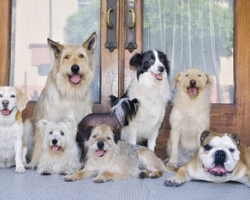When I was young, there was a neighborhood dog that absolutely hated every dog he met. If a strange dog walked by the fence, fierce barking and snarling would continue until the offender left the area. When this dog would encounter another pup out on a walk, all hell would break loose. When the gate was left open and he got out, he would immediately attack the first dog he saw and sometimes be so violent that he’d draw blood. Everyone in the neighborhood was terrified of this eight-pound, dog-aggressive Chihuahua.
No matter which breed you own, a certain amount of dog versus dog conflict is normal. Preventing problems and keeping the peace between dogs is the job of every responsible dog owner. Not unlike rowdy kids on the playground, dogs need good leadership and clear direction to make sure everybody plays by the rules.
According to Animal Farm Foundation, “Dog tolerance levels vary. It’s important to know your dog’s limits with other dogs. Does he have a short fuse, a long fuse or something in between? Be realistic about what he can put up with from other dogs and what kind of play or behavior he will not tolerate. Dog tolerance levels can and do change with age and circumstance. Young pups can become much more dog selective as they mature and unsocialized adults can become more dog-tolerant with proper introductions and positive exposure to other dogs, especially dogs of the opposite sex.”
I’ve seen many dogs that go ballistic on a leash. I recently learned that this is called being leash reactive. This does not necessarily mean that the dog is dog aggressive. In many cases the same dog can play nicely with other dogs off-leash. Obedience classes that focus on distraction techniques can teach these dogs better leash manners.
AFF also says, “Even dogs that get along can break into an argument if one or both are offended or challenged. Be realistic about your dog’s tolerance level and help him succeed. Intervene so trouble can be averted long before an argument starts. If a real fight does happen, learn from it so it doesn’t happen again.” Understanding the dog’s body language helps dictate when to get involved. Dogs can be classified as:
Dog Social – Puppyish and great with all dogs
Dog Tolerant – Generally easy going with dogs; a long fuse
Dog Selective – Picky about which dogs will be tolerated
Dog Aggressive – Has a very short fuse with most or all dogs
Donna Reynolds, founder of BADRAP has had years of experience helping rescued dogs navigate their new world of rules. She says, “Obedience training can’t cure a dog of normal dog traits, but being a good leader will help you referee your pet’s interactions so he can have a positive experience. Once you’ve established the rules and you understand your dog’s limits, you can set him up for successful interactions and he’ll be much less likely to cross the line.”
“Just as with kids, fights can spark up from the most seemingly insignificant triggers,” says Reynolds. Some common triggers she points out are arguments over toys, food, favorite dogs or even favorite people – such arguments involve resource guarding. “A perceived challenge,” she continues, “such as intense eye contact, tug-of-war game or rough play can set a dog off. Watch out for excitement levels that spike when dogs slam into each other while chasing a squirrel or dashing to the sound of the doorbell. Knowing your dog’s triggers helps prevent trouble.”
AFF has fantastic advice that I try to follow, “Teach your dog that there are consequences for any inappropriate behavior with other dogs. Mark bad behavior with a firm verbal correction and remove your dog immediately from the situation. Your strong disapproval and the removal of the fun will make a point. On the flipside, remember to praise your dog for showing relaxed body language and good manners around other dogs. Always end on a positive while things are going well. Dogs are very intelligent and can certainly make good decisions with other well-socialized dogs when offered good direction and the best opportunities to succeed.”

